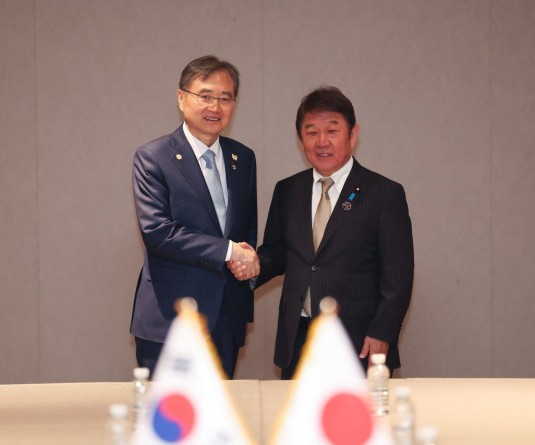
A man is scanned for levels of radiation in Koriyama, Fukushima Prefecture, Japan, Sunday, March 13. Friday's quake and tsunami damaged two nuclear reactors at a power plant in the prefecture, and at least one of them appeared to be going through a partial meltdown, raising fears of a radiation leak. (AP Photo)
KORIYAMA, Japan, March 13 (AP): Japan's nuclear crisis intensified Sunday as authorities raced to combat the threat of multiple reactor meltdowns and more than 170,000 people evacuated the quake- and tsunami-savaged northeastern coast where fears spread over possible radioactive contamination.
Nuclear plant operators were frantically trying to keep temperatures down in a series of nuclear reactors - including one where officials feared a partial meltdown could be happening Sunday - to prevent the disaster from growing worse.
Chief Cabinet Secretary Yukio Edano also said Sunday that a hydrogen explosion could occur at Unit 3 of the Fukushima Dai-ichi nuclear complex, the latest reactor to face a possible meltdown. That follows a blast the day before in the power plant's Unit 1, as operators attempted to prevent a meltdown there by injecting sea water into it.
"At the risk of raising further public concern, we cannot rule out the possibility of an explosion," Edano said. "If there is an explosion, however, there would be no significant impact on human health."
More than 170,000 people had been evacuated as a precaution, though Edano said the radioactivity released into the environment so far was so small it didn't pose any health threats.
"First I was worried about the quake," Kenji Koshiba, a construction worker who lives near the plant. "Now I'm worried about radiation." He spoke at an emergency center in Koriyama town near the power plant in Fukushima.
Edano said neither Fukushima Dai-ichi reactor was near the point of complete meltdown, and he was confident of escaping the worst scenarios. A complete meltdown - the collapse of a power plant's systems and its ability to keep temperatures under control - could release uranium and dangerous contaminants into the environment and pose major, widespread health risks.
Up to 160 people, including 60 elderly patients and medical staff who had been waiting for evacuation in the nearby town of Futabe, and 100 others evacuating by bus, might have been exposed to radiation, said Ryo Miyake, a spokesman from Japan's nuclear agency. The severity of their exposure, or if it had reached dangerous levels, was not clear. They were being taken to hospitals.
Edano said operators were trying to cool and decrease the pressure in the Unit 3 reactor, just as they had the day before at Unit 1.
Nuclear plant operators were frantically trying to keep temperatures down in a series of nuclear reactors - including one where officials feared a partial meltdown could be happening Sunday - to prevent the disaster from growing worse.
Chief Cabinet Secretary Yukio Edano also said Sunday that a hydrogen explosion could occur at Unit 3 of the Fukushima Dai-ichi nuclear complex, the latest reactor to face a possible meltdown. That follows a blast the day before in the power plant's Unit 1, as operators attempted to prevent a meltdown there by injecting sea water into it.
"At the risk of raising further public concern, we cannot rule out the possibility of an explosion," Edano said. "If there is an explosion, however, there would be no significant impact on human health."
More than 170,000 people had been evacuated as a precaution, though Edano said the radioactivity released into the environment so far was so small it didn't pose any health threats.
"First I was worried about the quake," Kenji Koshiba, a construction worker who lives near the plant. "Now I'm worried about radiation." He spoke at an emergency center in Koriyama town near the power plant in Fukushima.
Edano said neither Fukushima Dai-ichi reactor was near the point of complete meltdown, and he was confident of escaping the worst scenarios. A complete meltdown - the collapse of a power plant's systems and its ability to keep temperatures under control - could release uranium and dangerous contaminants into the environment and pose major, widespread health risks.
Up to 160 people, including 60 elderly patients and medical staff who had been waiting for evacuation in the nearby town of Futabe, and 100 others evacuating by bus, might have been exposed to radiation, said Ryo Miyake, a spokesman from Japan's nuclear agency. The severity of their exposure, or if it had reached dangerous levels, was not clear. They were being taken to hospitals.
Edano said operators were trying to cool and decrease the pressure in the Unit 3 reactor, just as they had the day before at Unit 1.
Survivors of 2004 tsunami shaken by Japan disaster
BANDA ACEH, Indonesia: Tears streamed down Maisara Mucharam's face as she watched aerial shots of the tsunami pummeling Japan's coast and remembered the day, six years ago, when her youngest daughter was ripped out of her arms by the heavy salty sea.
Survivors of the 2004 tsunami that started off Indonesia sat glued to their TV sets, stroking each other's hands, as images of last Friday's disaster in northern Japan flashed repeatedly across the screen.
"I heard someone screaming and ran to see what was going on," said Mucharam, who also lost her husband and two other daughters. "I tried, but couldn't stop watching," the 38-year-old said, her voice trembling. "It was exactly the same, except they have this horrible footage, events unfolding right before your eyes."
The magnitude 9.0 earthquake that struck on the morning of Dec. 26, 2004, spawned a tsunami that smashed into coastal communities, beach resorts and towns in 12 nations, killing more than 230,000 people.
Two-thirds of them died here in Indonesia's remote Aceh province, and it took days for images to emerge. Even then, most showed the aftermath: crumpled buildings, flattened landscapes and row upon row of swollen corpses.
"Unbelievable," whispered 39-year old Cut Chalidah, who lost a son and nine other family members, as she watched the 23-foot (7-meter) high wall of water wash over Japan's coast, rolling up everything in its path. "So this is what it looked like."
She sat silent as the television showed cars, ships and even buildings lifted up and carried inland, tossed about in the debris-strewn water like floating toys in a running bath.
The images left 13-year-old Zaki Ramadhan, orphaned in the 2004 disaster, struggling to breathe.
"My chest was tight, I couldn't feel my legs," said the boy, now being raised by his grandparents. "All I could think of was my mom and dad, my sisters. ... They disappeared under water, just like that."
In Sri Lanka and Thailand, both also hit by the 2004 tsunami, some survivors said the pictures brought back tears and nightmares that had all but stopped.
"It's exactly like what happened in my village," Tharmalingam Komila, who lives in Sri Lanka's coastal village of Passikudah, said as she watched the rescue operations in Japan on TV.
"I was dragged away by the wave into the sea," said the 29-year-old, who lost more than two dozen relatives. "I was holding onto a big plastic jar and a log for five hours before people in an army helicopter saw me and saved me."
For others, the unfolding events reminded them of Japan's outpouring of support after the 2004 tsunami, the food, medical supplies and other assistance delivered to Indonesia by ship, plane and helicopter even after others had scaled back operations.
"I wish there was something I could do," said Muhammad Nazri, 42, who lives in Banda Aceh, the provincial capital. "I'd like to go there, really, even if it was just to share my feelings of grief."
Survivors of the 2004 tsunami that started off Indonesia sat glued to their TV sets, stroking each other's hands, as images of last Friday's disaster in northern Japan flashed repeatedly across the screen.
"I heard someone screaming and ran to see what was going on," said Mucharam, who also lost her husband and two other daughters. "I tried, but couldn't stop watching," the 38-year-old said, her voice trembling. "It was exactly the same, except they have this horrible footage, events unfolding right before your eyes."
The magnitude 9.0 earthquake that struck on the morning of Dec. 26, 2004, spawned a tsunami that smashed into coastal communities, beach resorts and towns in 12 nations, killing more than 230,000 people.
Two-thirds of them died here in Indonesia's remote Aceh province, and it took days for images to emerge. Even then, most showed the aftermath: crumpled buildings, flattened landscapes and row upon row of swollen corpses.
"Unbelievable," whispered 39-year old Cut Chalidah, who lost a son and nine other family members, as she watched the 23-foot (7-meter) high wall of water wash over Japan's coast, rolling up everything in its path. "So this is what it looked like."
She sat silent as the television showed cars, ships and even buildings lifted up and carried inland, tossed about in the debris-strewn water like floating toys in a running bath.
The images left 13-year-old Zaki Ramadhan, orphaned in the 2004 disaster, struggling to breathe.
"My chest was tight, I couldn't feel my legs," said the boy, now being raised by his grandparents. "All I could think of was my mom and dad, my sisters. ... They disappeared under water, just like that."
In Sri Lanka and Thailand, both also hit by the 2004 tsunami, some survivors said the pictures brought back tears and nightmares that had all but stopped.
"It's exactly like what happened in my village," Tharmalingam Komila, who lives in Sri Lanka's coastal village of Passikudah, said as she watched the rescue operations in Japan on TV.
"I was dragged away by the wave into the sea," said the 29-year-old, who lost more than two dozen relatives. "I was holding onto a big plastic jar and a log for five hours before people in an army helicopter saw me and saved me."
For others, the unfolding events reminded them of Japan's outpouring of support after the 2004 tsunami, the food, medical supplies and other assistance delivered to Indonesia by ship, plane and helicopter even after others had scaled back operations.
"I wish there was something I could do," said Muhammad Nazri, 42, who lives in Banda Aceh, the provincial capital. "I'd like to go there, really, even if it was just to share my feelings of grief."
‘Nation facing worst crisis since WW II’
TAGAJO: The death toll in Japan’s earthquake and tsunami will likely exceed 10,000 in one state alone, an official said Sunday, as millions of survivors were left without drinking water, electricity and proper food along the pulverized northeastern coast.
“This is Japan’s most severe crisis since the war ended 65 years ago,” Prime Minister Naoto Kan told reporters, adding that Japan’s future would be decided by the response to this crisis.
Although the government doubled the number of soldiers deployed in the aid effort to 100,000, it seemed overwhelmed by what’s turning out to be a triple disaster: Friday’s quake and tsunami damaged two nuclear reactors at a power plant on the coast, and at least one of them appeared to be going through a partial meltdown, raising fears of a radiation leak.
The police chief of Miyagi prefecture, or state, told a gathering of disaster relief officials that his estimate for deaths was more than 10,000, police spokesman Go Sugawara told The Associated Press. Miyagi has a population of 2.3 million and is one of the three prefectures hardest hit in Friday’s disaster. Only 379 people have officially been confirmed dead.
TAGAJO: The death toll in Japan’s earthquake and tsunami will likely exceed 10,000 in one state alone, an official said Sunday, as millions of survivors were left without drinking water, electricity and proper food along the pulverized northeastern coast.
“This is Japan’s most severe crisis since the war ended 65 years ago,” Prime Minister Naoto Kan told reporters, adding that Japan’s future would be decided by the response to this crisis.
Although the government doubled the number of soldiers deployed in the aid effort to 100,000, it seemed overwhelmed by what’s turning out to be a triple disaster: Friday’s quake and tsunami damaged two nuclear reactors at a power plant on the coast, and at least one of them appeared to be going through a partial meltdown, raising fears of a radiation leak.
The police chief of Miyagi prefecture, or state, told a gathering of disaster relief officials that his estimate for deaths was more than 10,000, police spokesman Go Sugawara told The Associated Press. Miyagi has a population of 2.3 million and is one of the three prefectures hardest hit in Friday’s disaster. Only 379 people have officially been confirmed dead.






